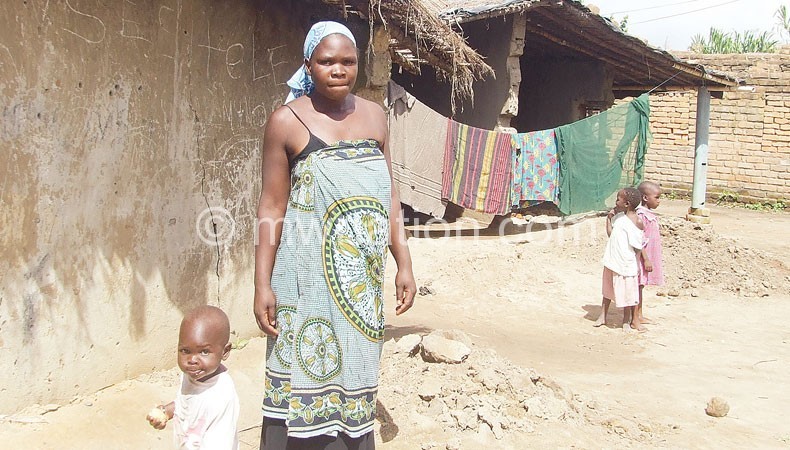Towards resilient cities

Mzuzu catastrophe exposes gaps in disaster management plans that tend to focus on rural settings only.
Tiwonge Ngwira, a charcoal maker with four children, always worries when the rainy season starts. Ngwira’s household was forced to shift into a neighbouring hut in March when two nights of heavy rains destroyed half of a four-bedroom, grass-thatched house and left the other side with cracks.
Last month, three weeks of relentless rains left them scampering back to the dilapidated house they had abandoned as their hut of refuge became inhabitable. Standing in the middle of the rubble, the Zolozolo West resident lamented: “The ruins remind us about the good times; we are living like refugees in our own compound.”
A face of urban poverty, the affected houses in the waterlogged area are made of sun-baked bricks with mud mortar. The cracked walls are wet and the thatches leaky. In the vicinity, some have planted sugarcane as fences. The majority of the settlements in the city are marshy and drainage is nearly nonexistent.
It is no surprise the densely inhabited Zolozolo West in Ching’ambo wetlands is one of the worst hit townships in the March disaster which destroyed 919 households and rendered 4 600 people homeless in Mzuzu, says the city’s disaster management committee chairperson Kenneth Sakala.
Authorities say Mzuzu has never experienced a disaster of this magnitude, a major blow to the city dwellers who are often sidelined in disaster and risk management. Even the Department of Disaster and Risk Management had not visited the affected population three weeks after they were struck by the catastrophe.
“Until it struck, it never occurred to me that city residents would be affected by a disaster this size,” says Ngwira, a pregnant woman, with a two-year-old toddle saddling on her back. She quit school in Standard Eight when she had her firstborn, a 10-year-old who goes to St Augustine Primary School on the Northern end of the city.
In her neighborhood, four houses have crumbled and about five have survived with gaping cracks. She rates food, accommodation and sanitation as urgent needs—amid uncertainty on how she and her husband will rebuild the fallen houses.
“How will we reconstruct the houses when we have been reduced to hand-to-mouth livelihood?” she wonders.
Her cry echoed all over the high-density township Botanic Garden Plots, an emerging upscale locality where mansions of the city’s businesspeople and white-collar executives are standing intact. An unpaved road splits the two settings into a shocking contrast resembling the uptown Area 47 and Ntandire slum in Lilongwe.
Zolozolo is crammed by low income earners, such as charcoal traders, guards, sex workers, vegetable vendors and other members of the informal sector with no insurance or savings to help them cope with effects of disasters.
For years, its cheap housing has become an attraction for influx of young Malawians migrating from rural areas in search for better opportunities in the city. It is the resultant scramble for housing that pushes the likes of Ngwira’s family to build in risky spots.
Sakala only came short of calling Zolozolo West a good example of bad town planning.
“Mzuzu City is not necessarily a town planning crisis, but population growth is increasing pressure for land and people are just building anyhow,” he says.
Ngwira’s household has a tap nearby, but most dwellers in Ching’ambo wetlands rely on wells. The water points are often dug adjacent to pit latrines, both filled with ground water. The prevalence of well-like pit latrines, which are outlawed by the city’s bylaws, could be heightening the seepage of human waste into underground water, a ticking sanitation crisis in the setting with a history of diarrhoea, cholera and other waterborne diseases.
However, the destruction of several toilets, kitchens, bathrooms and other sanitation crisis could be another crisis about to happen.
Interestingly, Mzuzu City Council chief executive officer Thomas Chirwa seems aware of the time bomb.
He says: “Sanitation is very critical as most affected areas have become deplorable. Let us safeguard their health first and we can look at reconstruction later.”
The city boss terms the crisis “a wake-up call” that urban areas are not immune to disasters. The effects of sidelining urban populations in disaster management have been glaring. The city council took almost three weeks to meet stakeholders and spell out the casualty rates.
Chirwa says the response has been “very slow” and “the council has not done much to assist.”
He explains: “This largely borders on perception. Most people, even decision makers seem to think that city councils have the capacity to handle disasters, but how are we going to reconstruct homes for those who cannot afford shelter?
“The council did not have contingency plans to rebuild 900 houses. We will rely on support of the bigger public to reconstruct so that the survivors can begin again and lead a normal life after the tragedy.”
The tragedy has left people living in crumbling huts and some families have been separated, with children dispatched to friends and relatives.
World Vision, a non-governmental organisation that exists to create a better world for children and other vulnerable population, was the first to donate relief items including blankets, tents and water treatments, to the worst hit households.
The organisation’s human emergency affairs manager Dingiswayo Jere says there is need for urgent interventions to curb the crisis from worsening.
“Mzuzu is crowded. If we don’t manage this disaster now, it may grow into a bigger crisis,” says Jere, wondering why the country’s cities continue to be sidelined in disaster issues though they are suffering graver impacts due to overcrowding.
As the affected residents are waking up to the effects of misplaced slums and precarious town planning, the country must also rise from the long slumber of limiting urban disasters to fires the size which gutted the city’s market the fateful day the rains destroyed houses in Zolozolo, Chibanja, Luwinga, Masasa and other townships.





